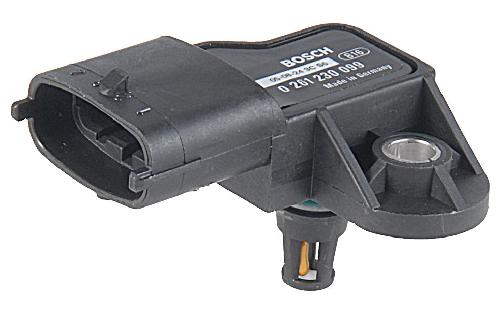
P0107 - Manifold Absolute/Barometric Pressure Circuit Low Input
Content
DTC P0107 OBD-II - Datasheet
Manifold absolute/barometric pressure circuit input low.
DTC P0107 appears on the vehicle dashboard when the engine control module (ECU, ECM, or PCM) detects that the MAP sensor signal voltage is below 0,25 volts.
What does trouble code P0107 mean?
This Diagnostic Trouble Code (DTC) is a generic transmission code, which means it applies to OBD-II equipped vehicles. Although general, specific repair steps may differ depending on the brand / model.
The manifold absolute pressure (MAP) sensor reacts to changes in the pressure (vacuum) in the intake manifold. The sensor is supplied with 5 volts from the PCM (Powertrain Control Module).
There is a resistor inside the MAP sensor that moves depending on the manifold pressure. The resistor changes the voltage from about 1 to 4.5 volts (depending on engine load) and this voltage signal is returned to the PCM to indicate manifold pressure (vacuum). This signal is important for the PCM to determine the fuel supply. DTC P0107 sets when the PCM sees the MAP signal voltage is less than 25 volts, which is too low.

Possible symptoms
Every time the MAP sensor signal is low, the car will likely have a very difficult start. Other symptoms may include:
- It's hard to start
- Long cranking time
- Spraying / missing
- Intermittently stalls
- Malfunction Indicator Lamp (MIL) Illumination
- Reduced overall engine performance.
- Launch difficulty.
- Difficult gear shifting.
- Excessive fuel consumption.
- Black smoke comes out of the exhaust pipe.
These are symptoms that can also appear in connection with other error codes.
Causes of the P0107 code
The Manifold Absolute Pressure (MAP) sensor monitors the pressure in the intake manifolds, which are used to determine the amount of air drawn into the engine without load. The principle of operation of this sensor is quite simple. Inside is a diaphragm that flexes under the action of incoming pressure. Strain gauges are connected to this diaphragm, which register changes in length corresponding to a certain electrical resistance. This change in electrical resistance is transmitted to the engine control module, which thus has the opportunity to check the correct operation of this device. When the voltage of the sent signal registers the signal is lower than 0,25 volts, therefore does not correspond to the normal values,
The most common reasons to track down this code are as follows:
- Malfunction of the pressure sensor in the intake manifold.
- Wiring defect due to bare wire or short circuit.
- Electrical connection problems.
- Defective connectors, e.g. due to oxidation.
- Possible malfunction of the engine control module, incorrect sending of the fault code.
- Bad MAP sensor
- Open or short circuit in the signal circuit
- Open or short circuit in the 5V reference circuit
- Ground circuit open or closed
- Bad PCM
Possible solutions
First, use a scan tool with the key ON and engine running to monitor the MAP sensor voltage. If it reads less than 5 volts, turn off the engine, disconnect the MAP sensor and, using a DVOM (digital volt / ohmmeter), check for 5 volts on the 5 volt reference circuit.
1. If there is no 5 volts in the reference circuit, check the reference voltage at the PCM connector. If present at the PCM connector but not at the MAP connector, repair open in the reference circuit between the PCM and the MAP harness connector. If the 5V reference is NOT present at the PCM connector, check the power and ground to the PCM and repair/replace if necessary. (NOTE: On Chrysler products, a shorted crank sensor, vehicle speed sensor, or any other sensor that uses a 5V reference from the PCM can short the 5V reference. To fix this, simply unplug each sensor one at a time until will be 5 V. the link appears again. The last disconnected sensor is the sensor with a short circuit.)
2. If you have a 5V reference on the MAP connector, jumper the 5V reference circuit to the signal circuit. Now check the MAP voltage on the scan tool. It should be between 4.5 and 5 volts. If so, replace the MAP sensor. If not, repair open / short in the signal circuit wiring and recheck.
3. If ok, do wiggle test. Start the engine, pull the harness, connector and press on the MAP sensor. Pay attention to any changes in voltage or engine speed. Repair the connector, harness, or sensor as needed.
4. If the wiggle test is confirmed, use a vacuum pump (or simply use your lungs) to create a vacuum at the vacuum port of the MAP sensor. As the vacuum is added, the voltage should decrease. If there is no vacuum, the MAP sensor should read approximately 4.5 V. If the scan tool MAP sensor reading does not change, replace the MAP sensor.
MAP sensor DTCs: P0105, P0106, P0108 and P0109.
Repair Tips
After the vehicle is taken to the workshop, the mechanic will usually perform the following steps to properly diagnose the problem:
- Scan for error codes with an appropriate OBC-II scanner. Once this is done and after the codes have been reset, we will continue to test drive on the road to see if the codes reappear.
- With the engine off, use a voltmeter to check for the presence of 5 volts in the circuit according to the standard.
- Checking the MAP sensor.
- Inspection of connectors.
- Inspection of the electrical wiring system.
- Checking the electrical system.
Rushing to replace the MAP sensor is not recommended, as the cause of DTC P0107 may lie elsewhere.
Generally, the repair that most often cleans up this code is as follows:
- Replacement or repair of the MAP sensor.
- Replacement or repair of faulty electrical wiring elements.
- Connector repair.
Driving with error code P0107 is not recommended, as this can seriously affect the stability of the car on the road. For this reason, you should get your car to the workshop as soon as possible. Given the complexity of the inspections being carried out, the DIY option in the home garage is unfortunately not feasible.
It is difficult to estimate the upcoming costs, since a lot depends on the results of the diagnostics carried out by the mechanic. As a rule, the cost of replacing a MAP sensor in a workshop, depending on the model, is about 60 euros.
Frequently Asked Questions (FAQ)
What does code P0107 mean?
DTC P0107 indicates that the MAP sensor signal voltage is below 0,25 volts.
What causes the P0107 code?
MAP sensor failure and faulty wiring are the most common causes that cause this DTC.
How to fix code P0107?
Carefully inspect the MAP sensor and all components associated with it, including the wiring system.
Can code P0107 go away on its own?
The code in some cases may disappear on its own. However, it is always recommended to check the MAP sensor.
Can I drive with code P0107?
Circulation, even if possible, is not recommended as it may affect the vehicle's stability on the road.
How much does it cost to fix code P0107?
On average, the cost of replacing a MAP sensor in a workshop, depending on the model, is about 60 euros.
Need more help with your p0107 code?
If you still need help with DTC P0107, post a question in the comments below this article.
NOTE. This information is provided for informational purposes only. It is not intended to be used as a repair recommendation and we are not responsible for any action you take on any vehicle. All information on this site is protected by copyright.

One comment
gugun
How to solve the dtc code p 0107 Hilux diesel 1 kd